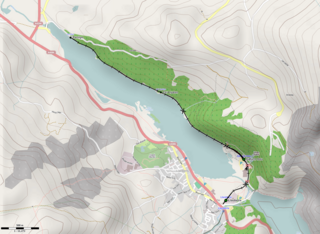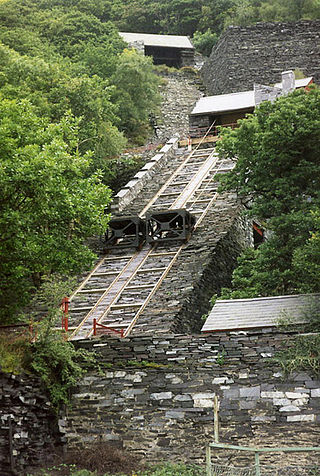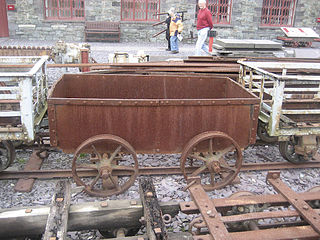
The Narrow Gauge Railway Museum is a purpose-built museum dedicated to narrow-gauge railways situated at the Tywyn Wharf station of the Talyllyn Railway in Tywyn, Gwynedd, Wales.

The Llanberis Lake Railway is a 1 ft 11+1⁄2 in narrow gauge heritage railway that runs for 2.5 miles (4 km) along the northern shore of Llyn Padarn in north Wales in the Snowdonia National Park. The starting point is the village of Llanberis at the eastern end of the lake, with the western terminus at Pen Llyn in the Padarn Country Park. The return journey takes around 60 minutes.

A cable railway is a railway that uses a cable, rope or chain to haul trains. It is a specific type of cable transportation.

The Penrhyn Quarry Railway was a narrow gauge railway in Caernarfonshire, Wales. It served the Penrhyn quarry near Bethesda, taking their slate produce to Port Penrhyn, near Bangor. The railway was around six miles (9.7 km) long and used a gauge of 1 ft 10+3⁄4 in.

The Padarn Railway was a narrow gauge railway in North Wales, built to the unusual gauge of 4 ft. It carried slate seven miles (11 km) from Dinorwic Quarry to Port Dinorwic. The line opened on 3 March 1843, replacing the Dinorwic Railway. It initially used horses, but was converted to steam haulage on 23 November 1848. The railway was formally titled the Dinorwic Quarries Railway or Dinorwic Quarry Railway, but informally "Padarn Railway" was widely used.

The Nantlle Railway was a Welsh narrow gauge railway. It was built to carry slate from several slate quarries across the Nantlle Valley to the harbour at Caernarfon for export by sea. The line provided a passenger service between Caernarfon and Talysarn from 1856 to 1865. It was the first public railway to be operated in North Wales.
The Dinorwic Railway was an early 2 ft narrow gauge industrial railway connecting the slate quarry at Dinorwic in Caernarvonshire with the coastal port at Y Felinheli. The line is sometimes referred to as the Dinorwic Tramroad or the Dinorwic Tramway.

Dinorwic quarry is a large former slate quarry, now home to the Welsh National Slate Museum, located between the villages of Llanberis and Dinorwig in Wales. At its height at the turn of the century, it was the second largest slate quarry in Wales, after the neighbouring Penrhyn quarry near Bethesda. Dinorwic covered 700 acres (283 ha) consisting of two main quarry sections with 20 galleries in each. Extensive internal tramway systems connected the quarries using inclines to transport slate between galleries. Since its closure in 1969, the quarry has become the site of the National Slate Museum, a regular film location, and an extreme rock climbing destination.

The Eigiau Tramway might refer to the Eigiau Quarry Tramway or to the Eigiau Reservoir Tramway.

Oakeley quarry is a slate quarry in the town of Blaenau Ffestiniog, north Wales. It was the largest underground slate mine in the world, and had 26 floors spanning a vertical height of nearly 1,500 feet (460 m).

Fire Queen is an early steam locomotive built by A. Horlock and Co in 1848 for the Padarn Railway. It is the only surviving locomotive from that railway, and it is preserved at the Penrhyn Castle Railway Museum.

The Dinorwic Alice Class is a class of eleven narrow-gauge 0-4-0ST steam locomotives built specifically for the Dinorwic Slate Quarry. These locomotives were built by the Hunslet Engine Company between 1886 and 1904, and were designed and supplied specifically to work the many galleries of the quarry at Llanberis, North Wales.

Maid Marian is a preserved narrow-gauge steam locomotive built in 1903, currently based at the Bala Lake Railway in North Wales.

Cilgwyn quarry is a slate quarry located on the north edge of the Nantlle Vale, in North Wales. It is one of the earliest slate quarries in Great Britain, being worked as early as the 12th century. King Edward I of England was reputed to have stayed in a house roofed by Cilgwyn slates, during the Welsh wars of independence. It is one of the major slate quarries in the Nantlle Valley area.

Graig Ddu quarry is a disused slate quarry near Blaenau Ffestiniog, in Gwynedd, North Wales. Although output was only about 3,000 tons a year, it reputedly has 36 saw tables and the same number of dressing machines on site. As with others in the area, the quarry suffered from a lack of water, resulting in the siting of the mill some distance away, at a lower level.

Gilfach Ddu (LLR) railway station is an intermediate station on the Llanberis Lake Railway (LLR), located in Llanberis, Gwynedd, Wales.

Cei Llydan is an intermediate railway station on the Llanberis Lake Railway (LLR), located in Llanberis, Gwynedd, Wales.

Penllyn (LLR) railway station is the northern terminus of the Llanberis Lake Railway (LLR), located near Llanberis, Gwynedd, Wales. The station has no platforms and passengers are not allowed to board or alight.
![<span class="mw-page-title-main">Slate industry in the Nantlle Valley</span> Slate quarries in the [[Nantlle Valley]]](https://upload.wikimedia.org/wikipedia/commons/thumb/c/ce/Dorothea_pumping_engine_and_Penyrorsedd_Quarries_-_geograph.org.uk_-_300611.jpg/320px-Dorothea_pumping_engine_and_Penyrorsedd_Quarries_-_geograph.org.uk_-_300611.jpg)
The Slate Industry in the Nantlle Valley was the major industry of the area. The Nantlle Valley is the site of oldest slate quarry in Wales at Cilgwyn, and during the nineteenth and twentieth centuries it was a major centre of the Slate industry in Wales. The quarries of the area are a World Heritage site.

Gilfach Ddu are a series of well preserved Grade I listed industrial buildings built to serve the Dinorwic slate quarry near Llanberis in Caernarfonshire, North Wales. The workshops are a complex of repair and maintenance buildings, that were built in 1870 to build and maintain the machinery used in the quarry. The complex includes saw sheds, patternmaking shops, a foundry with copula, blacksmiths shops, fitting shops, stores, engine sheds, a canteen, the chief engineers house, a hand operated crane and two waterwheels which provided the site with its power. Since 1972 the buildings have housed the National Slate Museum.





















![<span class="mw-page-title-main">Slate industry in the Nantlle Valley</span> Slate quarries in the [[Nantlle Valley]]](https://upload.wikimedia.org/wikipedia/commons/thumb/c/ce/Dorothea_pumping_engine_and_Penyrorsedd_Quarries_-_geograph.org.uk_-_300611.jpg/320px-Dorothea_pumping_engine_and_Penyrorsedd_Quarries_-_geograph.org.uk_-_300611.jpg)

